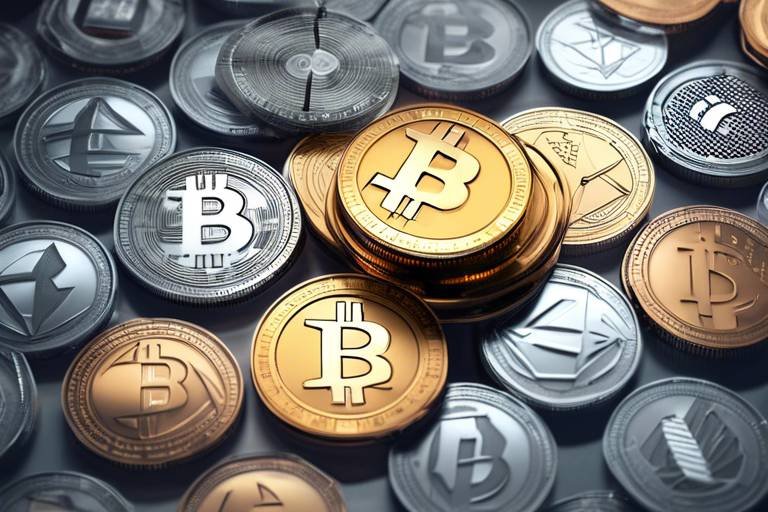Market Predictions - What Analysts Expect for Altcoins
As we dive into the world of cryptocurrencies, particularly altcoins, it's essential to understand the dynamic landscape that shapes their market potential. Analysts and experts are constantly analyzing patterns, trends, and the myriad of factors that influence the performance of these digital assets. With the recent fluctuations in the crypto market, many investors are eager to know what the future holds for altcoins. Will they soar to new heights, or are we in for a bumpy ride? This article explores the anticipated trends and insights from analysts regarding altcoins, offering a comprehensive overview of the market landscape and potential investment opportunities in the coming months.
The altcoin market is currently experiencing a wave of exciting trends that are capturing the attention of both seasoned investors and newcomers. As Bitcoin continues to dominate headlines, many investors are turning their gaze towards altcoins, seeking the next big opportunity. Recent movements have shown that altcoins like Ethereum, Cardano, and Solana are not just surviving but thriving, with significant price increases and adoption rates. This surge can be attributed to several factors:
- Increased Institutional Investment: More institutional players are entering the altcoin space, providing a much-needed boost in credibility and liquidity.
- Technological Advancements: Ongoing developments in blockchain technology are making altcoins more appealing.
- Market Diversification: Investors are looking to diversify their portfolios beyond Bitcoin, leading to increased interest in altcoins.
When it comes to predicting the future of altcoins, expert analysts are divided, with some leaning towards a bullish outlook while others adopt a more cautious stance. Many analysts believe that the altcoin market is poised for significant growth, driven by increased adoption and technological innovations. For instance, Ethereum's upcoming upgrades are expected to enhance its scalability and efficiency, which could attract more users and developers. On the other hand, some analysts warn of potential market corrections and advise investors to stay vigilant.
Understanding the factors that influence altcoin prices is crucial for any investor looking to navigate the volatile crypto market. Here are some key elements that analysts consider:
Market sentiment plays a pivotal role in shaping altcoin prices. Positive news, such as partnerships or technological breakthroughs, can lead to a surge in prices, while negative news can trigger sell-offs. Investors often rely on social media trends and news outlets to gauge market sentiment, making it an essential factor for anyone looking to invest in altcoins.
Technological advancements are another significant factor that can drive altcoin growth. Innovations such as blockchain upgrades, new project launches, and improved transaction speeds can enhance the utility and attractiveness of altcoins. For example, the introduction of decentralized finance (DeFi) platforms has opened up new avenues for altcoin usage, thereby increasing their value and market presence.
Regulatory developments are a double-edged sword in the altcoin market. While clear regulations can provide a framework for growth and stability, sudden changes or crackdowns can lead to panic selling. Analysts closely monitor regulatory news, as it can significantly impact trading and investment strategies. Keeping an eye on government interventions and potential legislation is essential for anyone involved in the altcoin space.
As the altcoin market evolves, so do the strategies for investing in it. Here are some effective approaches that can help investors maximize their returns:
Investors often find themselves at a crossroads when deciding between long-term and short-term investment strategies. Long-term investments can provide stability and the potential for substantial gains, especially if one believes in the future of a specific altcoin. Conversely, short-term trading can capitalize on market volatility, allowing investors to profit from quick price movements. Each approach has its benefits and risks, and understanding your risk tolerance is key to making the right choice.
Identifying promising altcoins requires thorough research and analysis. Investors should focus on:
- Market cap analysis to gauge the potential for growth.
- Understanding project fundamentals, including the team behind it and its use case.
- Keeping an eye on community engagement and sentiment.
By employing these strategies, investors can make informed decisions and potentially uncover the next big altcoin.
Q: What are altcoins?
A: Altcoins are any cryptocurrencies other than Bitcoin. They often aim to improve upon Bitcoin's technology or offer new features.
Q: Why should I invest in altcoins?
A: Investing in altcoins can diversify your portfolio and potentially lead to higher returns, especially if you identify promising projects early.
Q: How can I stay updated on altcoin trends?
A: Follow crypto news outlets, join online communities, and keep an eye on market analysis from reputable sources to stay informed.
Q: Are altcoins risky investments?
A: Yes, altcoins can be highly volatile and risky. It's essential to do thorough research and consider your risk tolerance before investing.

Current Altcoin Trends
The altcoin market is buzzing with activity, and it's crucial to stay updated on the latest trends if you want to navigate this landscape successfully. As we dive into the current altcoin trends, you'll notice that several key movements are shaping the market. With the rise of decentralized finance (DeFi) and non-fungible tokens (NFTs), altcoins are no longer just the underdogs of the cryptocurrency world; they're becoming front-runners in innovation and adoption.
One of the most notable trends is the increasing interest in Layer 2 solutions. These protocols, built on top of existing blockchains, aim to enhance scalability and reduce transaction costs. For example, Ethereum's Layer 2 solutions like Polygon and Optimism are gaining traction as they allow developers to create faster and cheaper transactions. This shift is essential as it addresses the congestion issues that have plagued Ethereum, making it more appealing for both users and developers alike.
Moreover, the rise of stablecoins is another trend to watch. With their value pegged to traditional currencies, stablecoins like USDC and Tether provide a safe harbor for investors looking to avoid the volatility that often accompanies altcoins. As more investors flock to stablecoins for trading and investment, they are inadvertently driving demand for altcoins, as stablecoins are often used to purchase them. This dynamic creates a fascinating interplay between stability and volatility in the market.
Additionally, the emergence of decentralized autonomous organizations (DAOs) is reshaping how altcoins are governed. DAOs enable communities to make decisions collectively, which is a significant shift from traditional centralized governance models. This trend is attracting a new wave of investors who are interested in participating in projects that prioritize community involvement and transparency. As DAOs continue to gain popularity, expect to see a rise in altcoins that are governed by these innovative structures.
Another exciting trend is the integration of artificial intelligence (AI) within blockchain technology. Projects that leverage AI to enhance user experience and optimize trading strategies are becoming increasingly popular. For instance, platforms that utilize AI algorithms for predicting market movements or analyzing trading patterns are gaining traction. This intersection of AI and altcoins is an area ripe for exploration, and savvy investors should keep an eye on these developments.
Lastly, the impact of social media cannot be overlooked. Platforms like Twitter and Reddit have become vital in shaping market sentiment and driving altcoin prices. The power of a viral tweet or a trending discussion can send an altcoin soaring or plummeting within hours. As a result, investors must stay connected with online communities and social media trends to gauge the potential movements of their favorite altcoins.
| Trend | Description |
|---|---|
| Layer 2 Solutions | Protocols enhancing scalability and reducing transaction costs. |
| Stablecoins | Cryptocurrencies pegged to traditional currencies, providing stability. |
| Decentralized Autonomous Organizations (DAOs) | Community-driven governance models for altcoin projects. |
| Artificial Intelligence | AI applications optimizing trading strategies and user experiences. |
| Social Media Influence | The role of platforms in shaping market sentiment and price movements. |
In summary, the altcoin market is evolving rapidly, driven by technological advancements and changing investor behaviors. Staying informed about these trends is essential for anyone looking to invest in altcoins. Whether you're a seasoned trader or just starting, understanding these dynamics will help you make more informed decisions and potentially capitalize on emerging opportunities.

Expert Analyst Opinions
When it comes to investing in altcoins, the opinions of seasoned analysts can be a goldmine of insights. These experts, with their fingers on the pulse of the cryptocurrency market, provide invaluable perspectives on where altcoins might be headed. Some analysts are *bullish*, predicting substantial growth driven by technological advancements and increasing adoption, while others take a more *bearish* stance, cautioning investors about potential pitfalls and market volatility. So, what exactly are these analysts saying?
One prominent analyst recently stated that the altcoin market is on the brink of a *major breakout*. They believe that several altcoins, particularly those with strong use cases and active development teams, are poised for significant price increases. This sentiment is echoed by many in the community who argue that as Bitcoin stabilizes, investors will begin to look at altcoins for higher returns. In fact, the analyst highlighted a few altcoins that are currently gaining traction:
| Altcoin | Current Price | Market Cap | Analyst Rating |
|---|---|---|---|
| Ethereum (ETH) | $3,200 | $380 Billion | Strong Buy |
| Cardano (ADA) | $2.50 | $80 Billion | Buy |
| Solana (SOL) | $150 | $45 Billion | Hold |
However, not all analysts share the same enthusiasm. A few have pointed out the risks associated with investing in altcoins. They warn that the market is still largely speculative, and many altcoins may not survive the inevitable market corrections. This caution is particularly relevant given the recent regulatory scrutiny surrounding cryptocurrencies, which could lead to unpredictable price movements. As one analyst put it, “Investing in altcoins is like navigating a minefield; one wrong step can lead to significant losses.”
To summarize, the expert landscape is divided. Some analysts are optimistic about the potential of altcoins, while others urge caution. It’s crucial for investors to consider these varying perspectives and conduct their own research before diving into the altcoin market. After all, the world of cryptocurrency is ever-evolving, and staying informed is the key to making sound investment decisions.
- What should I look for in a promising altcoin? Look for strong fundamentals, a dedicated development team, and active community engagement.
- Are altcoins a good investment? While altcoins can offer high returns, they also come with higher risks compared to established cryptocurrencies like Bitcoin.
- How can I stay updated on altcoin trends? Follow reputable cryptocurrency news sources, join online forums, and keep an eye on market analysis from experts.

Factors Influencing Altcoin Prices
When it comes to the world of altcoins, understanding the factors that influence their prices is crucial for both seasoned investors and newcomers alike. The altcoin market is notoriously volatile, and prices can swing dramatically based on a variety of elements. So, what exactly drives these price changes? Let's dive into some of the key factors that can make or break an altcoin's value.
One of the primary influences on altcoin prices is market sentiment. This refers to the overall attitude of investors towards a particular asset or the market as a whole. When sentiment is positive, investors are more likely to buy, driving prices up. Conversely, negative sentiment can lead to panic selling, causing prices to plummet. Social media platforms and news outlets play a significant role in shaping this sentiment. For instance, a favorable tweet from a well-known influencer can spark a buying frenzy, while negative news can lead to widespread fear and selling.
Another critical factor is technological advancements. Altcoins are often built on innovative technologies that can enhance their functionality and appeal. For example, upgrades to blockchain protocols or the introduction of new features can attract more users and investors, thereby increasing demand and price. Projects that consistently innovate and improve their technologies tend to maintain a more robust market presence.
Additionally, regulatory changes can have a profound impact on altcoin prices. Governments around the world are still figuring out how to regulate cryptocurrencies, and any news of potential legislation can lead to significant price fluctuations. For instance, if a country announces that it will regulate altcoins, it can create a sense of legitimacy and safety for investors, leading to price increases. On the other hand, announcements of crackdowns or bans can trigger sell-offs as investors rush to minimize their losses.
Market dynamics such as liquidity also play a vital role. Liquidity refers to how easily an asset can be bought or sold without affecting its price. Altcoins with higher liquidity tend to be less volatile since large transactions have a lesser impact on their prices. Conversely, low liquidity can lead to sharp price movements, making it essential for investors to consider the liquidity of an altcoin before diving in.
Lastly, investor behavior is influenced by speculation. Many altcoins are subject to speculative trading, where investors buy based on the belief that prices will rise rather than the underlying fundamentals of the project. This speculative nature can lead to rapid price increases, but it can also result in equally swift declines when the market corrects itself. Understanding these behaviors can help investors navigate the often-turbulent waters of altcoin investments.
In summary, the factors influencing altcoin prices are multifaceted, encompassing market sentiment, technological advancements, regulatory changes, liquidity, and investor behavior. Being aware of these elements can empower investors to make more informed decisions and potentially capitalize on market movements.
- What is market sentiment? Market sentiment refers to the overall attitude of investors towards a specific asset or the market as a whole, which can heavily influence price movements.
- How do technological advancements impact altcoin prices? Technological upgrades and innovations can enhance the functionality of an altcoin, attracting more users and potentially increasing its price.
- What role do regulations play in altcoin pricing? Regulatory changes can either legitimize an altcoin, driving prices up, or create panic and sell-offs if negative regulations are introduced.

Market Sentiment Analysis
Market sentiment plays a crucial role in shaping the dynamics of altcoin prices, acting as an invisible hand that can either propel a cryptocurrency to new heights or drag it down into the depths of despair. But what exactly is market sentiment? In simple terms, it refers to the overall attitude of investors towards a particular market or asset. This sentiment is often influenced by a myriad of factors, including recent news, social media trends, and the general mood of the trading community.
Imagine walking into a room filled with people discussing a new movie. If the buzz is overwhelmingly positive, you might feel inclined to watch it, right? Similarly, in the world of altcoins, when positive news circulates—be it a major partnership, technological advancement, or favorable regulatory news—investors tend to flock towards that asset, driving its price upwards. Conversely, negative news can create a ripple effect, causing panic selling and significant price drops.
To better understand market sentiment, we can break it down into a few key components:
- Investor Behavior: How investors react to news and market changes plays a pivotal role. For instance, during a bull market, investors may exhibit more risk-taking behavior, while in a bear market, fear often leads to conservative strategies.
- Social Media Trends: Platforms like Twitter and Reddit can amplify sentiments rapidly. A single tweet from a prominent figure can send prices soaring or plummeting, highlighting the power of social media in today's trading environment.
- News Impact: Major news events, such as regulatory announcements or technological breakthroughs, can sway investor sentiment dramatically. Keeping an ear to the ground for such developments is crucial for anyone looking to navigate the altcoin landscape.
Furthermore, sentiment analysis tools have emerged as essential resources for traders and investors. These tools aggregate data from social media, news articles, and forums to provide a snapshot of market sentiment. By analyzing this data, investors can gain insights into whether the market leans bullish or bearish. For example, a sudden spike in positive sentiment could indicate a buying opportunity, while a decline might signal caution.
In conclusion, understanding market sentiment is not just about gauging the mood of investors; it's about leveraging that knowledge to make informed trading decisions. As altcoins continue to evolve, those who can read the emotional pulse of the market will be better positioned to capitalize on opportunities and mitigate risks. In the fast-paced world of cryptocurrency, where emotions often reign supreme, being aware of market sentiment can make all the difference.
Q: What is market sentiment in cryptocurrency?
A: Market sentiment refers to the overall attitude of investors towards a particular cryptocurrency or the market as a whole, influenced by news, social media, and investor behavior.
Q: How can I gauge market sentiment?
A: You can gauge market sentiment by following social media trends, analyzing news articles, and using sentiment analysis tools that aggregate data from various sources.
Q: Why is market sentiment important for altcoin trading?
A: Market sentiment is important because it can lead to significant price movements. Understanding sentiment helps investors make informed decisions about when to buy or sell altcoins.

Technological Innovations
In the fast-paced world of cryptocurrency, play a pivotal role in shaping the landscape of altcoins. These advancements not only enhance the functionality and usability of various altcoins but also significantly influence investor sentiment and market dynamics. One of the most exciting areas of innovation is the development of blockchain technology, which serves as the backbone for most altcoins. Innovations such as improved consensus algorithms, scalability solutions, and interoperability protocols are making waves in the crypto community.
For instance, projects like Ethereum 2.0 are transitioning to a proof-of-stake (PoS) model, which promises to increase transaction speeds while reducing energy consumption. This shift is not just a technical upgrade; it reflects a broader trend towards sustainability in the crypto space, addressing one of the most significant criticisms of blockchain technology. As more altcoins adopt similar eco-friendly approaches, we can expect a surge in interest from environmentally conscious investors.
Moreover, the rise of decentralized finance (DeFi) platforms has opened new avenues for altcoins. These platforms leverage smart contracts to facilitate financial services without intermediaries, creating a more inclusive financial ecosystem. Altcoins that are integral to DeFi protocols, such as Chainlink and Uniswap, are seeing increased adoption and, consequently, a rise in their market valuations. The technological advancements in this sector are not only transforming how we think about finance but also how we engage with altcoins.
Another area worth noting is the integration of non-fungible tokens (NFTs) into the altcoin market. NFTs have exploded in popularity, and many altcoins are now incorporating NFT functionalities to enhance their appeal. Projects that successfully merge NFTs with utility, such as gaming and digital art, are likely to see significant growth as they tap into new markets and demographics.
Furthermore, we cannot overlook the importance of security innovations. As the crypto market matures, so does the sophistication of cyber threats. Altcoin projects that prioritize robust security measures, such as advanced encryption techniques and decentralized identity solutions, will not only protect their users but also build trust within the community. This trust is crucial for long-term success and can be a significant differentiator in a crowded market.
In summary, the technological innovations within the altcoin space are not just about enhancing existing features; they are about transforming the entire ecosystem. As we look ahead, it will be fascinating to see which altcoins can leverage these innovations effectively to capture market share and drive investor interest. The future of altcoins is bright, and those who stay informed about these technological advancements will be better positioned to navigate the evolving landscape.
- What are the most significant technological innovations in altcoins?
The most significant innovations include blockchain upgrades, decentralized finance (DeFi) platforms, non-fungible tokens (NFTs), and enhanced security measures.
- How do technological advancements impact altcoin prices?
Technological advancements can lead to increased adoption and utility of altcoins, which often results in higher demand and subsequently, a rise in prices.
- Are eco-friendly altcoins gaining popularity?
Yes, eco-friendly altcoins that adopt sustainable practices, such as proof-of-stake mechanisms, are becoming increasingly popular among environmentally conscious investors.

Regulatory Impact on Altcoins
The world of altcoins is not just shaped by market trends and investor sentiment; it is also heavily influenced by regulatory developments. As governments and regulatory bodies around the globe begin to take a closer look at cryptocurrencies, the implications for altcoin markets can be profound. This scrutiny can lead to both opportunities and challenges for investors. For instance, when a country decides to adopt a more friendly regulatory stance towards cryptocurrencies, it can result in a surge in altcoin prices as investor confidence grows. Conversely, when regulations become stringent, it can lead to a decline in market activity and a drop in prices.
One of the key aspects of regulatory impact is the clarity and transparency that regulations can provide. When regulations are clear, it can encourage institutional investors to enter the altcoin market, bringing with them substantial capital and legitimacy. On the flip side, uncertainty around regulations can lead to market volatility. Investors often find themselves in a state of hesitation, unsure whether to buy, hold, or sell their altcoin assets. This uncertainty can create a ripple effect, impacting prices and trading volumes.
In recent years, we have witnessed various regulatory approaches across different jurisdictions. For example, some countries have embraced cryptocurrencies, establishing clear guidelines for their use, while others have taken a more cautious approach, imposing bans or restrictions. The table below illustrates some notable regulatory actions taken in the past year:
| Country | Regulatory Action | Impact on Altcoins |
|---|---|---|
| United States | Proposed new regulations for stablecoins | Increased scrutiny but potential for broader acceptance |
| China | Continued crackdown on cryptocurrency trading | Decreased market activity and investor confidence |
| European Union | Drafting the Markets in Crypto-Assets (MiCA) regulation | Potential for a unified regulatory framework |
| India | Taxation on cryptocurrency transactions | Increased legitimacy but concerns over high taxation |
As we can see, the regulatory landscape is constantly evolving, and its impact on altcoins cannot be overstated. Investors must stay informed about these changes, as they can significantly affect the viability and attractiveness of various altcoins. Keeping an eye on news from regulatory bodies and understanding the potential implications of new laws can give investors a competitive edge in this fast-paced market.
Furthermore, the regulatory environment is not just about restrictions; it can also foster innovation. For example, regulations that promote transparency and security can lead to the development of new altcoins that prioritize these values. As the market matures, we may see a shift towards altcoins that comply with regulatory standards, which could ultimately benefit investors looking for sustainable growth.
- How do regulations affect altcoin prices? Regulatory changes can lead to increased investor confidence or fear, directly impacting altcoin prices.
- Are all countries adopting similar regulations for altcoins? No, regulatory approaches vary significantly from one country to another, affecting how altcoins are traded and perceived.
- What should investors watch for in regulatory news? Investors should pay attention to proposed regulations, government statements, and enforcement actions that could influence market dynamics.

Investment Strategies for Altcoins
Investing in altcoins can be both thrilling and daunting. With the crypto landscape constantly changing, having a solid investment strategy is crucial for navigating this exciting market. First and foremost, diversification should be at the forefront of your investment approach. Just like you wouldn't put all your eggs in one basket, you shouldn't invest all your capital into a single altcoin. By spreading your investments across various altcoins, you can mitigate risks and potentially enhance your returns. Imagine you're a gardener; planting a variety of seeds increases the chances of a bountiful harvest, even if some plants don't thrive.
Another key aspect of a successful altcoin investment strategy is risk management. This involves setting clear limits on how much you're willing to invest in each altcoin and establishing stop-loss orders to protect your capital. For instance, if you invest $1,000 in an altcoin, consider setting a stop-loss at 20% below your purchase price. This way, if the market takes a downturn, you won't lose more than you're comfortable with. Think of it as wearing a seatbelt in a car; it won't prevent an accident, but it can certainly cushion the impact.
Timing the market is another critical factor in maximizing your returns. While it's nearly impossible to predict market movements with certainty, keeping an eye on market trends and news can help you make informed decisions. For example, if a major technological upgrade is announced for a specific altcoin, it might be wise to buy in before the price surges. Conversely, if negative news breaks, such as regulatory scrutiny, it might be best to reconsider your position. Staying informed is akin to being a detective; the more clues you gather, the better your chances of making a wise investment.
Moreover, understanding the fundamentals of the altcoins you're interested in is essential. This includes analyzing the project's whitepaper, the team behind it, and its use case. A well-researched investment is more likely to yield positive results. You wouldn't buy a car without checking its specifications and reviews, right? Similarly, conducting thorough research on altcoins can significantly enhance your chances of success.
For those interested in a more structured approach, consider employing a systematic investment strategy, such as dollar-cost averaging (DCA). This involves investing a fixed amount of money into an altcoin at regular intervals, regardless of its price. This strategy helps reduce the impact of volatility and can lead to better average purchase prices over time. It's like filling up your gas tank; you don't wait for prices to drop to fill up; instead, you just refuel regularly to avoid running on empty.
In summary, a successful investment strategy for altcoins should encompass diversification, risk management, market timing, fundamental analysis, and possibly systematic investment methods. By adopting these strategies, you can navigate the unpredictable waters of the altcoin market with greater confidence.
- What are altcoins? Altcoins are cryptocurrencies other than Bitcoin, often created to improve upon its features or to serve specific purposes within their ecosystems.
- How do I choose which altcoins to invest in? Look for altcoins with strong fundamentals, a dedicated team, a clear use case, and a solid community backing.
- Is investing in altcoins risky? Yes, investing in altcoins carries risks due to their volatility and the potential for loss. It's essential to conduct thorough research and manage your risks effectively.
- What is dollar-cost averaging? Dollar-cost averaging is an investment strategy where you invest a fixed amount of money at regular intervals, regardless of the asset's price.

Long-Term vs. Short-Term Investments
When it comes to investing in altcoins, one of the most crucial decisions you'll face is whether to adopt a long-term or short-term investment strategy. Each approach has its own set of advantages and challenges that can significantly impact your returns. So, how do you choose the right path? Let’s break it down.
Long-term investments are often likened to planting a tree. You put in your resources, nurture it, and wait patiently for it to grow. This strategy typically involves holding onto your altcoins for an extended period—often years—while the market matures and the technology behind the coins develops. Investors who adopt this strategy believe in the potential of altcoins to appreciate significantly over time, despite the volatility that may occur in the short run. For instance, many early adopters of Ethereum and Bitcoin saw substantial returns by holding onto their investments through thick and thin.
On the flip side, short-term investments can be compared to a game of chess. It requires quick thinking, strategy, and the ability to make rapid decisions based on market movements. Short-term investors, often referred to as traders, buy and sell altcoins within days or even hours, capitalizing on price fluctuations. This method can be exhilarating and offers the potential for quick profits, but it also comes with increased risk. The altcoin market is notoriously volatile, and prices can swing dramatically in a matter of minutes. Therefore, short-term investors must stay glued to their screens, watching for trends and news that could impact prices.
So, what should you consider when deciding between these two strategies? Here are a few factors:
- Risk Tolerance: If you’re comfortable with high volatility and potential losses, short-term trading may suit you. However, if you prefer a more stable approach, long-term investing might be the better option.
- Time Commitment: Short-term trading demands constant attention and quick decision-making, which can be time-consuming. Long-term investing, on the other hand, allows you to take a step back and monitor your investments periodically.
- Market Knowledge: Successful short-term trading requires a deep understanding of market trends and technical analysis. If you’re new to the crypto scene, starting with long-term investments might be a more prudent approach.
Ultimately, the choice between long-term and short-term investments isn't black and white. Many investors find success by combining both strategies, allocating a portion of their portfolio for long-term holds while actively trading a smaller portion. This hybrid approach can help mitigate risks while still allowing for potential short-term gains.
In conclusion, whether you choose to be a long-term investor or a short-term trader, the key is to remain informed and adaptable. The altcoin market is ever-evolving, and staying updated on trends, news, and technological advancements can help you make informed decisions that align with your investment goals.
Q: What is the best strategy for investing in altcoins?
A: The best strategy depends on your individual goals, risk tolerance, and market knowledge. A combination of both long-term and short-term strategies can often yield the best results.
Q: How do I determine which altcoins to invest in for the long term?
A: Research the project's fundamentals, team, market cap, and technological advancements. Look for coins with strong use cases and community support.
Q: Can I switch between long-term and short-term strategies?
A: Absolutely! Many investors adjust their strategies based on market conditions and personal circumstances.

Identifying Promising Altcoins
When it comes to investing in altcoins, the first step is to identify which ones are worth your time and money. With thousands of altcoins flooding the market, it can feel a bit like searching for a needle in a haystack. But don’t worry! There are several strategies you can employ to make the process smoother and more effective. Think of it as being a treasure hunter; you need the right tools and a good map to find the hidden gems.
One of the most crucial aspects of identifying promising altcoins is conducting thorough research. This means diving deep into the project’s whitepaper, understanding its use case, and evaluating the team behind it. A solid whitepaper will outline the project’s goals, technology, and roadmap. If the whitepaper is vague or poorly written, it’s often a red flag. Always look for projects that have clear, achievable objectives and a well-defined plan for how they intend to accomplish them.
Another vital factor to consider is the market capitalization of the altcoin. Generally, altcoins with a lower market cap have the potential for higher returns, but they also come with increased risk. On the flip side, larger market cap coins tend to be more stable but may not offer the same explosive growth potential. A balanced approach might involve a mix of both: investing in a handful of smaller altcoins while also holding established ones.
Additionally, keep an eye on community engagement. An active and engaged community can be a good indicator of a project's potential success. Check out social media channels, forums, and other platforms where investors and users discuss the altcoin. If you see a lot of positive sentiment and active discussions, it could be a good sign that the project has a supportive user base, which is essential for its growth.
Technological advancements are also a key component when assessing altcoins. Look for projects that are pushing the envelope with innovative technologies or unique solutions to existing problems. For example, if an altcoin is developing a new consensus algorithm or offering a novel approach to scalability, it may be worth considering. These technological innovations can often lead to increased interest and investment, driving up the price.
Lastly, don’t underestimate the power of market trends and sentiment. Keeping an eye on the broader cryptocurrency market can help you gauge whether it’s a good time to invest in altcoins. For instance, if Bitcoin is experiencing a bull run, altcoins often follow suit. Conversely, during bearish periods, many altcoins can suffer significant losses. Tools like sentiment analysis and market charts can provide insights into current trends.
In conclusion, identifying promising altcoins requires a mix of thorough research, market awareness, and a bit of intuition. By focusing on the fundamentals, analyzing market cap, engaging with the community, and keeping an eye on technological advancements, you can position yourself to make informed investment decisions. Remember, the crypto market is volatile, and while the potential for high rewards exists, so do the risks. Stay informed, stay curious, and happy investing!
- What is the best way to research altcoins?
Start by reading the project’s whitepaper, checking their website, and engaging with community forums. Analyzing social media sentiment can also provide insights.
- How do I determine if an altcoin is undervalued?
Look for coins with strong fundamentals, a solid development team, and a unique use case that hasn’t been fully recognized by the market yet.
- Is it better to invest in established altcoins or new projects?
It depends on your risk tolerance. Established altcoins tend to be more stable, while new projects can offer higher potential returns but come with greater risk.
Frequently Asked Questions
- What are altcoins?
Altcoins are any cryptocurrencies other than Bitcoin. They can vary widely in terms of technology, purpose, and market cap. Some popular examples include Ethereum, Ripple, and Litecoin. Think of altcoins as the diverse array of flavors in an ice cream shop, each offering something unique!
- How do I choose which altcoins to invest in?
Choosing the right altcoins involves conducting thorough research. Look into the project’s fundamentals, team, market cap, and community support. It’s like picking a book to read; you want something that resonates with you and has a good storyline!
- What factors influence altcoin prices?
Altcoin prices are influenced by several factors, including market sentiment, technological advancements, and regulatory changes. Just like a weather forecast, these elements can change rapidly, impacting how investors feel and act about their investments.
- Is it better to invest in altcoins for the long term or short term?
This really depends on your investment strategy! Long-term investments can provide stability and growth over time, while short-term trading may offer quick profits but comes with higher risks. It’s like deciding whether to plant a tree or pick fruit from a garden; both have their merits!
- How can I stay updated on altcoin market trends?
To stay updated, follow reputable news sources, subscribe to crypto analysis platforms, and engage with online communities. Social media platforms like Twitter and Reddit can also provide real-time insights and discussions. It’s like tuning into your favorite radio station for the latest hits!
- What is the role of market sentiment in altcoin trading?
Market sentiment reflects how investors feel about the market and can greatly influence trading decisions. Positive news can drive prices up, while negative news can lead to sell-offs. Think of it as the mood of a crowd at a concert; it can shift from excitement to disappointment in an instant!
- Are regulatory changes important for altcoin investments?
Absolutely! Regulatory changes can have a significant impact on altcoin markets, affecting everything from trading practices to project viability. It's akin to how new laws can change the rules of a game; they can make some strategies obsolete while creating new opportunities!



















